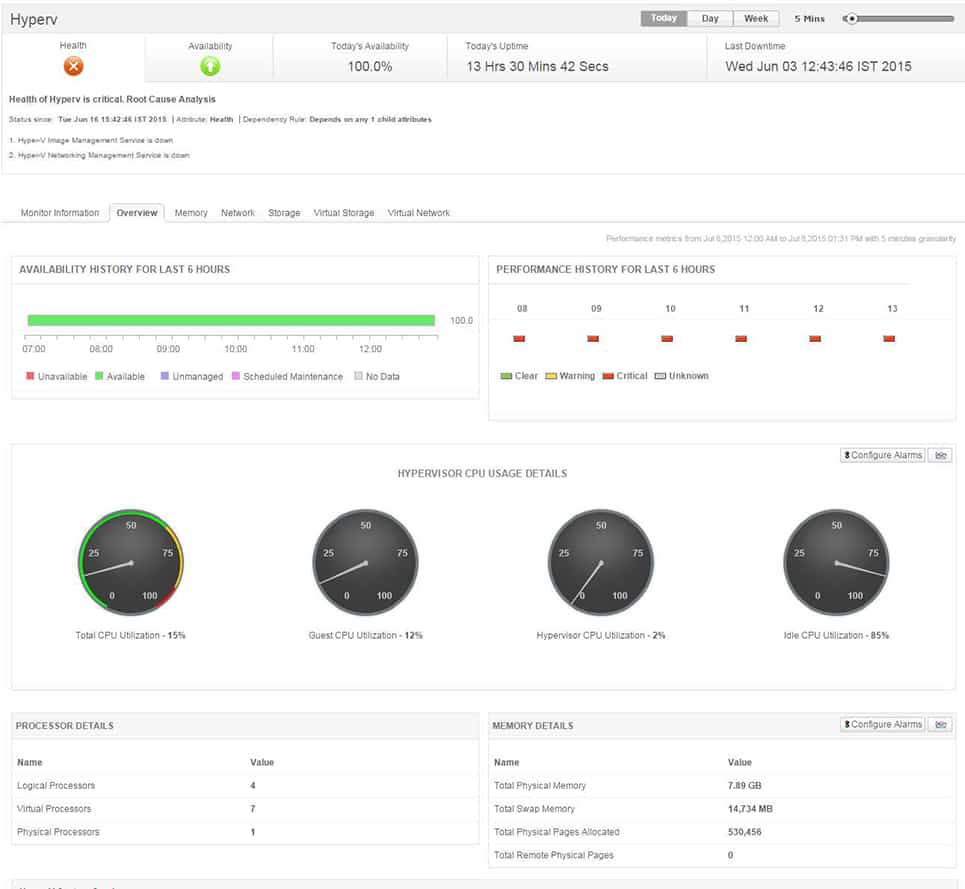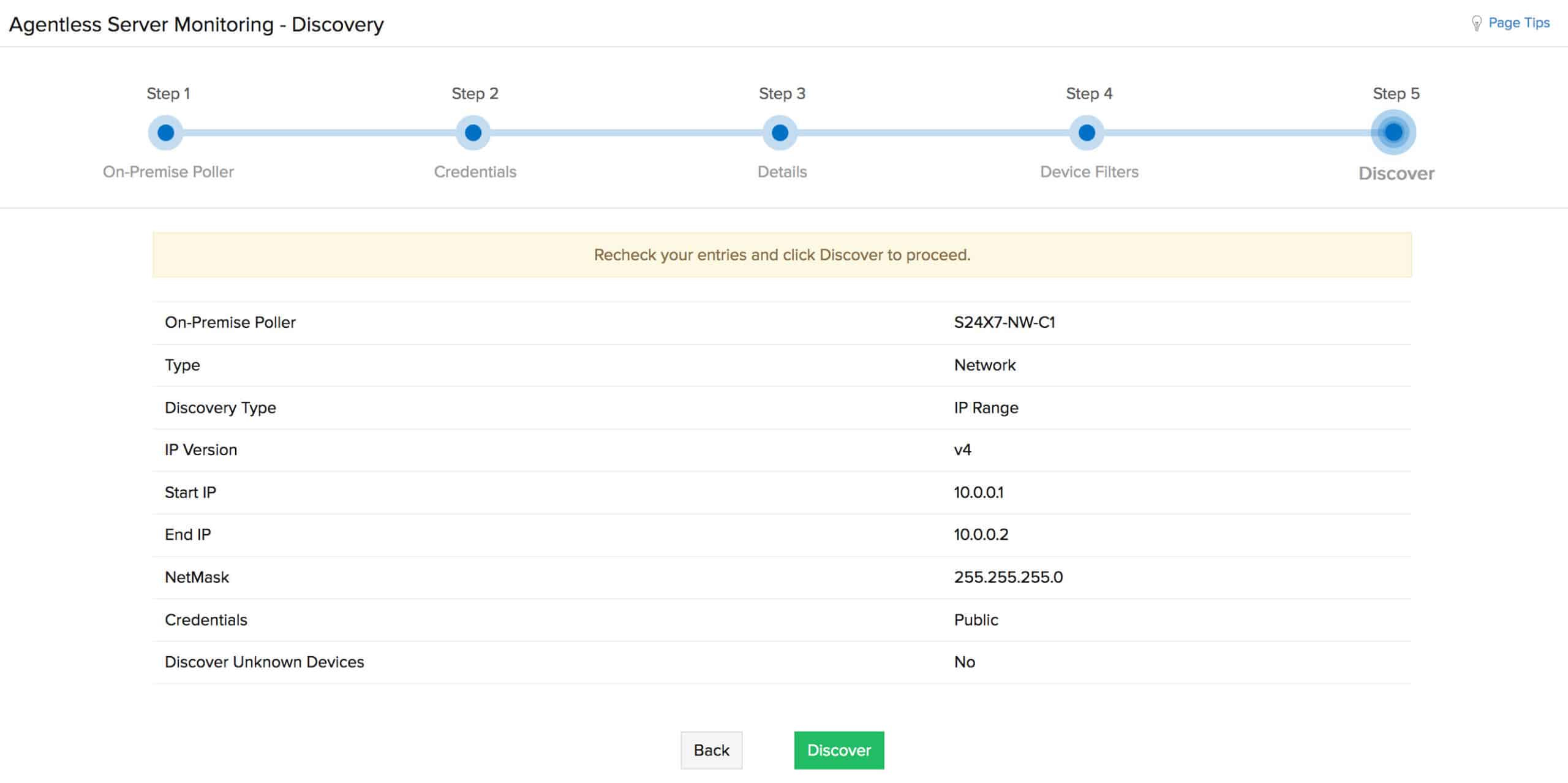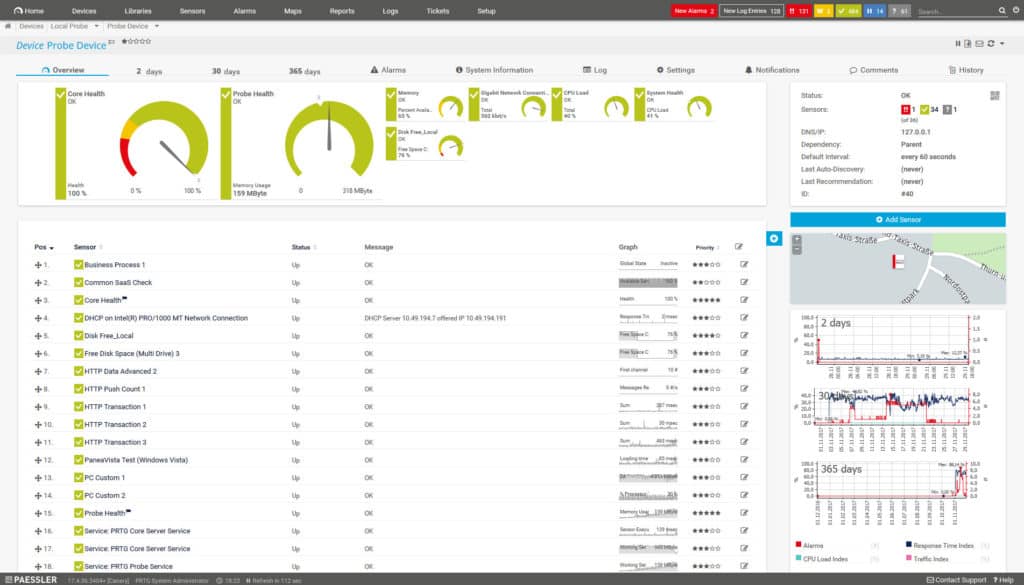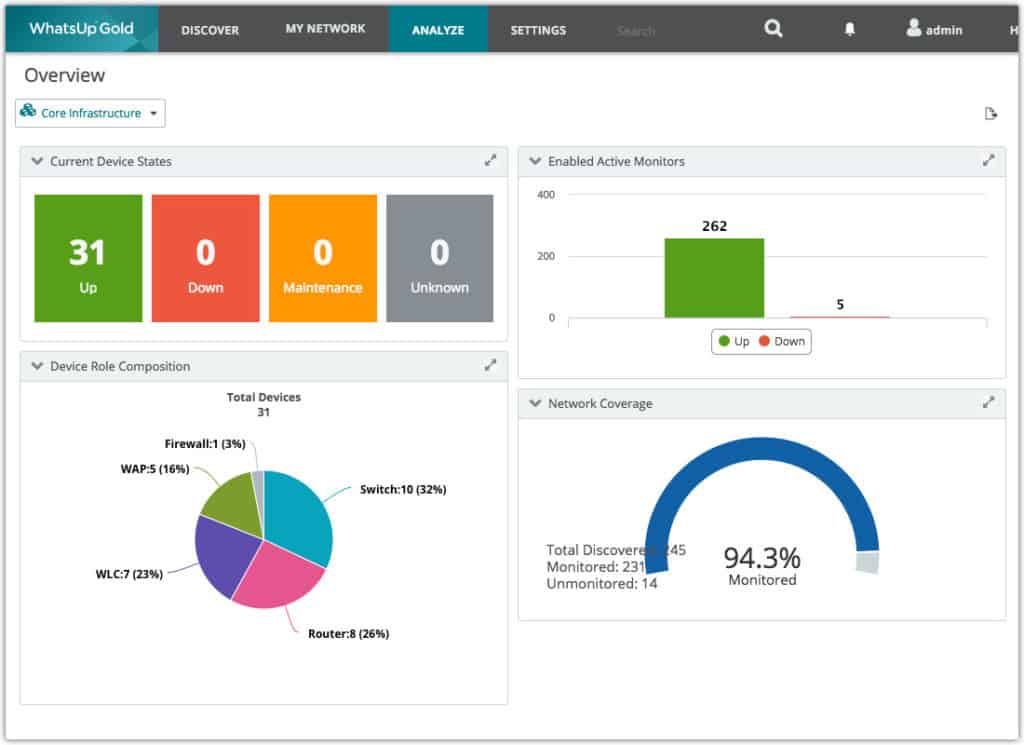The more established network monitoring tools have become, the higher the expectations of enterprises have risen. Companies from SME’s to multinational organizations are demanding a seamless infrastructure monitoring experience. Agentless monitoring has emerged as one of the most efficient methods for managing enterprise networks. In this article we’re going to look at what agentless monitoring is, and the best agentless monitoring tools.
We get into a lot of detail on each of the tools below, but in case you are after a quick list and free trial links, here is our list of the best agentless monitoring tools:
- ManageEngine Applications Manager EDITOR’S CHOICE An agentless monitoring system that can track the performance of more than 500 applications without the need for an agent. Installs on Windows Server and Linux.
- Site24x7 Agentless Server Monitoring (FREE TRIAL) A cloud-based tool that monitors IT infrastructure, application, and users in either an agent-based or agentless architecture. Agents available for Windows, Linux, Free BSD, and Solaris.
- Paessler PRTG Network Monitor (FREE TRIAL) A combined network, server, and application monitoring system that can be customized by choosing which monitors to implement.
- SolarWinds Network Performance Monitor An SNMP-based network monitor that communicates with network devices to maintain system health.
- WhatsUp Gold A network monitoring tool that can be extended to include server and application monitoring.
What is agentless monitoring?
Agentless monitoring is a method of tracking and managing IT systems, applications, and networks without requiring software agents to be installed on the monitored devices.
Instead, it relies on existing protocols, APIs, or tools like SNMP (Simple Network Management Protocol), WMI (Windows Management Instrumentation), or SSH to collect data from devices and systems. This approach simplifies deployment and reduces the overhead associated with installing and maintaining agents across multiple endpoints.
In agentless monitoring, the monitoring tool communicates directly with the device or system to gather performance metrics, log information, or configuration details. Since no additional software is running on the monitored systems, it minimizes resource consumption and potential compatibility issues. Agentless monitoring is commonly used for tracking server health, network performance, and application availability in environments where ease of setup and minimal system impact are priorities.
Agentless monitoring is ideal for lightweight, scalable setups and environments where minimal intrusion or quick deployment is critical, such as monitoring virtual machines, cloud services, or network devices. Its simplicity and efficiency make it an essential tool in modern IT operations.
Agentless Monitoring vs. Agent-Based Monitoring
The main difference between agentless and agent-based monitoring lies in how data is collected:
- Agent-Based Monitoring: Requires installing software (agents) on devices to collect detailed data locally. This method offers deep insights and control but requires more maintenance.
- Agentless Monitoring: Relies on existing network protocols without installing additional software. It’s easier to set up and manage but may offer less granular data.
The best agentless monitoring tools
Our methodology for selecting agentless monitoring tools
We reviewed the market for monitoring systems that can track performance without installing agents and analyzed options based on the following criteria:
- Asset discovery and inventory creation
- The ability to work with existing data-gathering mechanisms
- Built-in protocols, such as SNMP and NetFlow
- Uses operating system utilities, such as Ping and TraceRoute
- Alerts for performance problems
- A free trial or a demo package that provides an assessment opportunity before buying
- Value for money from a good set of tools that is offered at a fair price.
With these selection criteria in mind, we looked for a number of system monitoring tools that don’t need to install agents.
1. ManageEngine Applications Manager (FREE TRIAL)
ManageEngine Applications Manager is able to track the performance of more than 500 different applications without the need for agents. The system is able to monitor systems both on-premises and on the cloud. It not only watches over the applications you run on the sites that the monitoring software is hosted but it can also supervise applications running on remote sites.
Key Features:
- On-premises system
- Automatic discovery
- Application dependency mapping
Why do we recommend it?
ManageEngine Applications Manager is a close competitor to the SolarWinds Server & Application Monitor. Like the SolarWinds tool, this package can monitor the server on which it is installed and the other applications that run on it without an agent. It needs an agent to monitor other servers and also for cloud platform monitoring.
The applications that this service can monitor without the need for an agent include virtualizations, such as Hyper-V and VMWare, and database management systems, including SQL Server and MySQL. Other application categories that can be monitored by Applications Manager include mail servers and Web servers.
There are a couple of monitoring services within the Applications Manager bundle that do require agents. These are APM Insight for Web transaction monitoring and the End User Monitoring module.
The Applications Manager is a package of software that needs to be hosted. It is available for Windows Server and Linux. ManageEngine produces the monitoring system in three editions. These are: Free, Professional, and Enterprise. The Free version will only operate five monitors of your choice. There is no limit to the number of monitors that can be run simultaneously by the Professional edition but some advanced monitoring services are not included in that plan. The Enterprise edition has it all, including complex monitoring systems, such as distributed tracing for microservices.
Who is it recommended for?
This package is suitable for businesses of all sizes. However, any business that runs more than one server will need to install agents to get the system working properly. The software runs on Windows Server, Linux, AWS, and Azure. There is a Free edition that will monitor five assets.
Pros:
- Offers on-premise and cloud deployment options, giving companies more choices for install
- Can highlight interdependencies between applications to map out how performance issues can impact businesses operations
- Offers log monitoring to track metrics like memory usage, disk IO, and cache status, providing a holistic view into your database health
- Can automatically detect databases, server hardware, and devices for real-time asset management
Cons:
- Can take time to fully explore all features and options available
ManageEngine offers Applications Manager on a 30-day free trial.
EDITOR'S CHOICE
ManageEngine Applications Manager is our top pick for an agentless monitoring system because it delivers a powerful, flexible, and easy-to-use solution for monitoring applications, servers, databases, and cloud services without requiring software agents. Its agentless architecture simplifies deployment, reduces overhead, and ensures minimal impact on system performance, making it ideal for organizations seeking efficient and scalable monitoring. An important service of Applications Manager is its ability to monitor a wide range of technologies, including Java, .NET, cloud platforms (AWS, Azure, GCP), databases, and virtualization tools. This versatility ensures comprehensive visibility across your entire IT infrastructure. The agentless approach leverages protocols like SNMP, WMI, and SSH to collect data, eliminating the need for installing and maintaining agents on each monitored device. Applications Manager excels in providing real-time insights through intuitive dashboards, customizable reports, and automated alerts. These features enable IT teams to proactively identify and resolve performance bottlenecks, ensuring optimal application availability and user experience. Its root cause analysis capabilities further streamline troubleshooting by pinpointing the source of issues quickly. Additionally, Applications Manager offers seamless integration with other ManageEngine tools and third-party platforms, enhancing its functionality and adaptability. Its scalable architecture supports businesses of all sizes, from small teams to large enterprises.
Download: Get a 30-day FREE Trial
Official Site: https://www.manageengine.com/products/applications_manager/download.html
OS: Windows Server, Linux, AWS, and Azure
2. Site24x7 Agentless Server Monitoring (FREE TRIAL)
Site24x7 Server Monitoring is available with and without agents. The agentless monitoring service can pick up a lot of information from your network and servers. However, the agent-based version can gather a lot more categories of data.
Key Features:
- Serverless option
- Based in the cloud
- Better operations with agent
Why do we recommend it?
Site24x7 Agentless Server Monitoring is performed from a cloud platform. The Site24x7 system works better when agents are installed. In order for the system to operate without local agents, it would require the firewall to pass through all requests from the Site24x7 platform and that is a security risk.
The tool monitors IT infrastructure, applications, and end-users. The network monitoring systems in the package don’t need agents to be installed because they can query information gathered by the pre-installed device agents that are resident on all network equipment as an industry standard. Monitoring other equipment, such as servers, without agents is problematic.
Site24x7 can function without agent software being installed on the server, but there are a lot fewer metrics that the agentless version can gather. For example, it is easy for the remote server to measure the roundtrip time (RTT) to the server being examined. However, gathering information on the operations of the server requires queries to be executed on that server. These data-gathering functions are the reason that remote monitors rely on a piece of software running on the target server.
The agent-based and agentless versions of Site24x7 use the same console. However, they are set up in different ways. With the agent-based system, agents can be installed in bulk on Windows and Linux servers. The agentless version needs an IP address or a range of addresses to be entered into the console’s settings.
Who is it recommended for?
Although there is a possibility of monitoring network devices remotely by exploiting the SNMP agents that are already resident on switches and routers, monitoring server process data without an agent would be almost impossible. The system requires a local agent to gather and send system activity data.
Pros:
- One of the most holistic monitoring tools available, supporting networks, infrastructure, and real user monitoring in a single platform
- Uses real-time data to discover devices and build charts, network maps, and inventory reports
- Is one of the most user-friendly network monitoring tools available
- User monitoring can help bridge the gap between technical issues, user behavior, and business metrics
- Supports a freeware version for testing
Cons:
- Is a very detailed platform that will require time to fully learn all of its features and options
Site24x7 is a cloud-based service, available in four editions. The Free version is limited to monitoring five servers. Any of the four paid versions are available on a 30-day free trial.
3. Paessler PRTG Network Monitor (FREE TRIAL)
Paessler PRTG Network Monitor is an agentless network monitoring tool with a modern user interface. PRTG Network Monitor uses SNMP, WMI, NetFlow, IPFIX, jFlow, sFlow, and packet sniffing to pull information from connected devices. The software also has an auto-discovery feature that finds connected devices by IP range. Once devices are added to the monitoring environment they can then be monitored in the form of a network map, which details the relationships between the systems.
Key Features:
- On-premises package
- Networks, servers, and applications
- Free option
Why do we recommend it?
Paessler PRTG Network Monitor is available as a SaaS platform or as a software package for local installation. The on-premises version can implement agentless monitoring of network devices and it can also implement traffic analysis by communicating with the components that are already installed on switches and routers.
The dashboard experience delivered by PRTG Network Monitor is very high quality. The tool displays live network data in real-time through customizable dashboards that provide a range of graphs and charts. There are over 300 different map objects for you to choose from so you have complete control over how you monitor your network.
For on-premises licenses, PRTG Network Monitor includes a single failover. The single failover means that if the central node of a cluster goes down another node will step in and resume its responsibilities. The free failover helps to ensure that the network stays available even if there is an outage.
Who is it recommended for?
PRTG can monitor networks without agents but its server and application monitoring modules only work for the host on which the monitor is installed. You would need agents on any other server that you want to monitor. You only pay for the monitoring services that you activate and you can use 100 for free.
Pros:
- Uses a combination of packet sniffing, WMI, and SNMP to report network performance as well as discover new devices
- Autodiscovery reflects the latest inventory changes almost instantaneously
- Drag and drop editor makes it easy to build custom views and reports
- Supports a wide range of alert mediums such as SMS, email, and third-party integration
- Supports a freeware version
Cons:
- Is a very comprehensive platform with many features and moving parts that require time to learn
- Custom sensors can sometimes be challenging to manually configure
PRTG Network Monitor is available as a free or paid product. Paid versions of PRTG Network Monitor start at $1,347 (£1,075) for five sensors and one server installation up to $12,912 (£10,308) for unlimited servers and one server installation. There is also an unlimited version with five server installations that costs $50,523 (£40,337). You can download the 30-day free trial version.
4. SolarWinds Network Performance Monitor
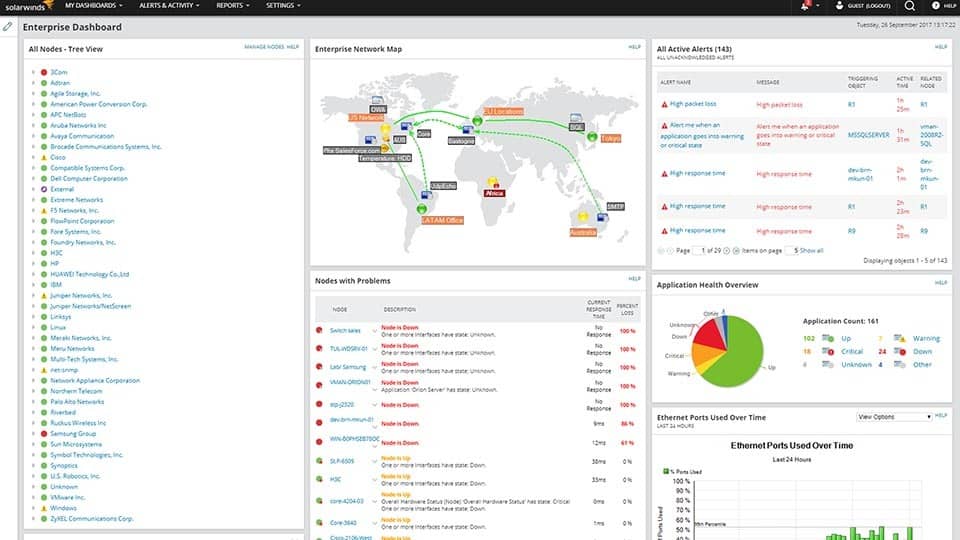
SolarWinds Network Performance Monitor is a network monitoring platform designed for those with scalability in mind. You can monitor devices developed by a range of vendors through the dashboard which displays a status overview of all connected devices and servers. There are also more advanced views like NetPath that show a topological network path. NetPath shows you how devices connect to each other and can be used to diagnose problems that you might have missed from the dashboard.
Key Features:
- Acts as an SNMP Manager
- Uses Ping and TraceRoute
- Device discovery
- Topology mapping
- Asset inventory management
Why do we recommend it?
SolarWinds Network Performance Monitoring doesn’t need to provide its own agents to monitor a network because it runs on a server connected to the network and communicates with pre-installed agents that are resident on each network device. This is thanks to the Simple Network Management Protocol which is implemented on all switches and routers.
For larger networks, there are a variety of features that support monitoring at scale. One of these is the Enterprise Operations Console which collects performance data from SolarWinds servers and shows it on a centralized dashboard. The EOC dashboard is more comprehensive than the standard dashboard and shows you sections such as Network Devices, Enterprise Nodes, Orion Site Status, Hosts, Enterprise Servers, Applications, Cisco Gear, and All Alerts.
SolarWinds Network Performance Monitor uses an alerts system that works by setting performance baselines that determine the trigger conditions for notifications. Alert conditions are also configurable based on a variety of trigger conditions. Options for trigger conditions include high response time, host CPU utilization, and Alert me when a transaction goes down.
Who is it recommended for?
This is a network monitoring service for large businesses. The tool includes an autodiscovery function that compiles a network inventory. The inventory is updated when devices are added, moved, or removed. Each SNMP poll results in status information for each device, which this package shows in its dashboard as live monitoring data.
Pros:
- Supports auto-discovery that builds network topology maps and inventory lists in real-time based on devices that enter the network
- Has some of the best alerting features that balance effectiveness with ease of use
- Supports both SNMP monitoring as well as packet analysis, giving you more control over monitoring than similar tools
- Uses drag and drop widgets to customize the look and feel of the dashboard
- Tons of preconfigured templates, reports, and dashboard views
Cons:
- This is a feature-rich enterprise tool designed for sysadmin, non-technical users may some features overwhelming
As an agentless monitoring solution, SolarWinds Network Performance Monitor checks all the boxes as a responsive and easy-to-use solution for SME’s and large organizations. The price of SolarWinds Network Performance Monitor starts at $2,995 (£2,390). You can download the 30-day free trial.
You can enhance your network monitoring capabilities by adding the Network Traffic Analyzer to the Network Performance Monitor. These two tools are produced on a common platform, called Orion, and they fit together to create cross-modular features, such as the NetPath service. You can buy both of these tools together in the Network Bandwidth Analyzer Pack which is available for a 30-day free trial.
5. WhatsUp Gold
WhatsUp Gold is an agentless network monitor with auto-discovery. The platform automatically discovers devices and applications which you can then monitor through the dashboard or the map view. The product has a customizable dashboard with color-coded device status symbols. The network map shows you a topological perspective with color-coded devices where systems are classified as Up, Down, Maintenance, and more.
Key Features:
- Runs on Windows Server
- SNMP-based
- Network monitoring
Why do we recommend it?
The core service of WhatsUp Gold is network device monitoring and this can be implemented without its own agents by exploiting the SNMP device agents that are already installed on switches and routers. This package provides autodiscovery and inventory creation and it will also generate a network map.
The application monitoring capabilities of WhatsUp Gold are also very detailed. The Application Performance Monitoring plug-in allows the user to monitor web transaction scripts and response times to identify performance issues. There are also monitoring profiles included out-of-the-box for Microsoft Exchange, SQL, SharePoint, and Active Directory.
The tool has a Virtual Monitoring plug-in to enable the monitoring of virtualized environments. The Virtual Monitoring plug-in takes performance data from VMware and Hyper-V resources to make sure your visibility reaches right down to the hypervisor level. The alerts system notifies you if there are any performance issues you should be aware of.
Who is it recommended for?
WhatsUp Gold runs on Windows Server and it is suitable for use by mid-sized businesses. The central package can be expanded by add-on modules that provide server, application, network traffic, virtualization, and cloud system monitoring. Other than the network traffic analyzer, all of these functions require the installation of agents.
Pros:
- Uses simple visualizations to help provide at-a-glance insights
- Supports modular pricing, allowing companies to pay only for features they intend to use
- Can monitor LANs, WANs, and cloud-based applications such as container environments
Cons:
- Available only for Windows Server
- Modular upgrades might not be a good fit if you intend on utilizing all aspects of a networking monitor
- No cloud-based version available
To view the price of WhatsUp Gold you’ll have to request a quote from the company directly. Packages support from 1-25 devices right up to 2500-plus devices. The wide range of devices supported makes WhatsUp Gold ideal for larger enterprises that rely on scalability. There is also a free trial version that you can download via this link here.
Agentless monitoring: Infrastructure monitoring for the future
In scalable enterprise environments, agentless monitoring is a necessity. It provides the user with the flexibility to incorporate disparate vendors into their network while cutting down on administrative burdens. The agent-based approach of installing software agents on servers still has a place, but it doesn’t offer the malleability that agentless monitoring tools do.
Tools like ManageEngine Applications Manager and Site24x7 Agentless Server Monitoring have become some of the leading network monitoring tools. Agentless network monitoring tools that incorporate auto-discovery features and customizable dashboards drive a more seamless administrative experience that helps identify performance issues at all levels of the network.
Agentless monitoring FAQs
What is the difference between agent & agentless?
Agent-based monitoring installs a data gathering package on a monitored device. If a network is being monitored, only one agent needs to be installed on one server connected to the network. This is necessary if the system monitoring is operating remotely because firewalls block external system queries. If this type of activity were not blocked, the system would be vulnerable to hacker attacks. Agentless monitoring systems work better if they run on the network rather than on a cloud platform or remote site. They can collect log messages or use built-in reporting tools, such as SNMP to remove the need for an agent.
What are some reasons we would choose agentless monitoring?
Agentless monitoring tools are less intrusive because they don’t require extra processes to be operating in addition to the core monitoring service. An agentless system relies on existing reporting mechanisms within existing software and services. Agentless monitoring systems work better when installed locally because reporting systems rarely send their logs to remote monitors without the mediation of an agent.
How is agentless deployment done?
Agentless deployment is made possible by reporting tools being built into software and devices. For example, the SNMP system defines how data can be demanded from devices without the monitoring package needing to install its own agents on devices because network hardware is shipped with SNMP agents already resident.


